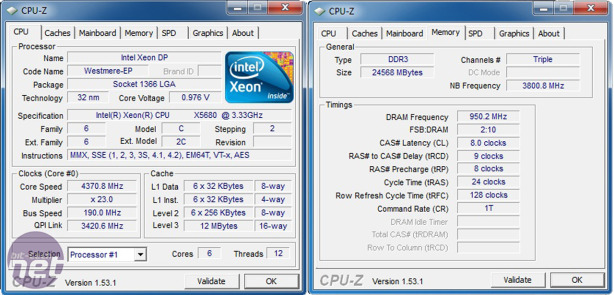Overclocking
As the CPU multiplier on all Xeons is locked upwards, the only way to overclock these CPUs is by increasing the QPI frequency above its stock 133MHz. However, overclocking a dual-processor motherboard is far more complex than a single socket board. This is because you not only face the challenge of keeping both CPUs in sync with each other, but are also limited by the way that one CPU will almost certainly overclock worse than another.Fortunately, the SR-2’s BIOS provides a number of adjustments to minimise these issues. You can for example set the vcore each processor socket provides to the CPU separately, which is useful if one CPU needs more voltage than another. Similarly, each bank of DIMMs and each VTT voltage can also be set independently. The voltage of the other components is controlled in the traditional way, as after all, despite having two CPUs, there is only one IOH (the Intel 5220 chipset) and one ICH (the Intel ICH10R Southbridge).
Besides the QPI, the BIOS can adjust a large number of other frequency settings, but to be honest we didn’t find changing any of them helped when overclocking. It doesn’t help that none of what these are documented and that EVGA’s tech support staff were unwilling to explain them to us, even when EVGA’s own PR manager was begging for help.
EVGA could also do with improving the user friendliness of its BIOSes. Like all its other boards you can’t enter voltages directly, instead you have to scroll through a huge list to find the voltage you want. This is a frustrating experience on a single-socket board such as the X58 Classified 4-Way SLI, but given the doubling up of voltage settings on the SR-2, it’s almost annoying enough to create rage tears. Fortunately, you can save your chosen BIOS settings in one of a number of profiles, something we’d definitely recommend doing as the SR-2 doesn’t recover well from bad overclocks – requiring a CMOS clear to POST again.
However, after several weeks in the lab, we reckon we’ve got a good grip on what the SR-2 is capable of. Our first task was to find out the highest maximum frequency the QPI bus would run above 133MHz was. Using a combination of Prime95 and 3DMark06 we eventually found that the SR-2 will happily run with a QPI of 190MHz for days on end. While this is a fair bit lower than the 220MHz of the best single-socket X58 motherboards, it’s a hell of a lot more than the ‘133MHz and no more’ that other dual Xeon motherboards are limited to.
This meant that using a QPI of 190MHz we were able to overclock a pair of mid-range Xeon X5650s from a comparatively stately 2.66GHz to a nippy 3.8GHz, vastly increasing the performance of the system in both single-threaded and multi-threaded applications and games. To stabilise this overclock we upped the vcore of each CPU to 1.4V, both VTTs to 1.45V, both banks of DIMMs to 1.66V and the IOH to 1.425V.
Unfortunately, although our pair of Xeon X5680s also supported a QPI of 190MHz, we had to lower the CPU multiplier from 25x to 23x. This resulted in the CPUs being overclocked from 3.33GHz to 4.37GHz. Apart from the vcore of each CPU, which we increased to 1.45V, the same voltages were used as in the previous overclock.
As not all Xeons support the same memory straps the Xeon 5650s would not POST when we set the RAM divider to 1,333MHz (10x) in the BIOS, only at 1,066MHz (8x). Because of this, when we overclocked the QPI to 190MHz the memory was limited to running at 1.52GHz. In contrast, the higher spec Xeon X5680s do support the 1,333MHz (10x) memory strap, so were able to run the memory at 1.9GHz.
If you’re not confident about your ability to overclock or are concerned about the warranty implications of overclocking then we’d strongly recommend checking out Scan’s various pre-overclocked warranty-backed bundles, reviewed after the SR-2 at the end of this article.

MSI MPG Velox 100R Chassis Review
October 14 2021 | 15:04










Want to comment? Please log in.